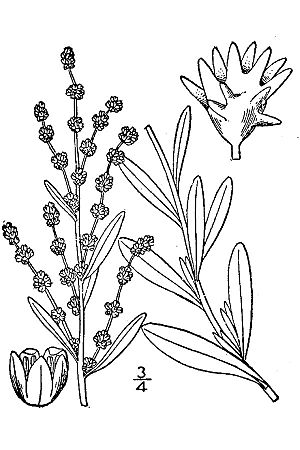Nuttall's saltbush facts for kids
Quick facts for kids Nuttall's saltbush |
|
|---|---|
 |
|
| Scientific classification | |
| Genus: |
Atriplex
|
| Species: |
nuttallii
|
Meet the Nuttall's saltbush (scientific name: Atriplex nuttallii). This amazing plant grows naturally across central and western North America. Some plant experts think it might be the same as another plant called Atriplex canescens.
Contents
Where Does It Grow?
Nuttall's saltbush is found in many places across North America. You can spot it from Washington state down to California. It also grows east into places like Saskatchewan in Canada and the Dakotas in the USA. You can find it south through Wyoming, Colorado, New Mexico, and Arizona. It even grows north into Nevada. This tough plant has also been seen in southern California.
Where It Likes to Live
This plant is super adaptable! It grows best in light or medium soils. It needs soil that drains water well. It can even grow in soil that doesn't have many nutrients. Nuttall's saltbush likes soils that are acid, neutral, or basic (alkaline). It needs lots of sunshine and cannot grow in shady spots. It prefers dry or moist soil conditions.
This plant is very special because it can handle a lot of salt in the soil. It can live in places with up to 13,000 parts per million of salt! Often, it's the only plant that can survive in very salty areas. It grows well in places that get about 150 to 280 millimeters (6 to 11 inches) of rain each year.
What Does It Look Like?
Nuttall's saltbush is an evergreen shrub. This means it stays green all year long. It can grow up to about 0.9 meters (3 feet) tall. These plants are usually low-growing and spread out. They form thick, flat patches close to the ground. If their branches touch the soil, they can even grow new roots!
Its leaves are directly attached to the stem, without a stalk. They are long and rounded at the tip. The leaves grow opposite each other on the lower parts of the stems. Higher up, they grow in an alternating pattern. The plant's bark is smooth, can soak up water, and is white. The leaves themselves are covered in tiny, dense scales, making them look dusty. They are about 7 to 18 millimeters (0.3 to 0.7 inches) wide.
Reproduction and Life Cycle
Nuttall's saltbush flowers between March and May. Its fruits, called utricles, ripen about 6 to 10 weeks later. These plants usually don't make a lot of seeds. However, they can still produce some seeds even during dry periods.
Most Nuttall's saltbush plants are dioecious. This means each plant has either only male flowers or only female flowers, but not both. Wind helps to spread their pollen. Sometimes, you might find a monoecious plant. This type has both male and female flowers on the same plant, but in separate spots.
How People and Animals Use It
Food Source
Nuttall's saltbush is a great food source for many animals. Livestock like sheep and cattle, and wild animals like antelope, mule deer, and rabbits, all eat it. Even mourning doves enjoy grazing on this plant. Its leaves are very important food, especially in winter. This is because the leaves stay on the plant all year. It's super helpful for sheep, as it provides important nutrients they need, especially when female sheep are pregnant.
Growing This Plant
If you want to grow Nuttall's saltbush, you can plant its seeds in the fall. The seeds need to be cold before they will sprout. It's suggested to use about 2.2 to 4.5 kilograms (5 to 10 pounds) of good seeds per harvest for planting.
The seeds should be spread in separate rows. Then, they need to be covered lightly with a harrow. It's important to plant them close to the soil surface, less than 1.3 centimeters (0.5 inches) deep. In the first year, the young plants grow quickly and strongly. They keep growing as long as there is enough moisture in the soil.

